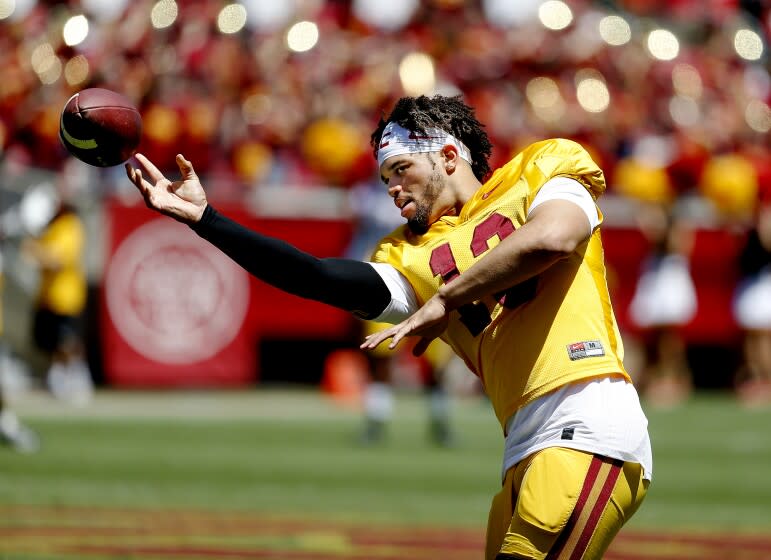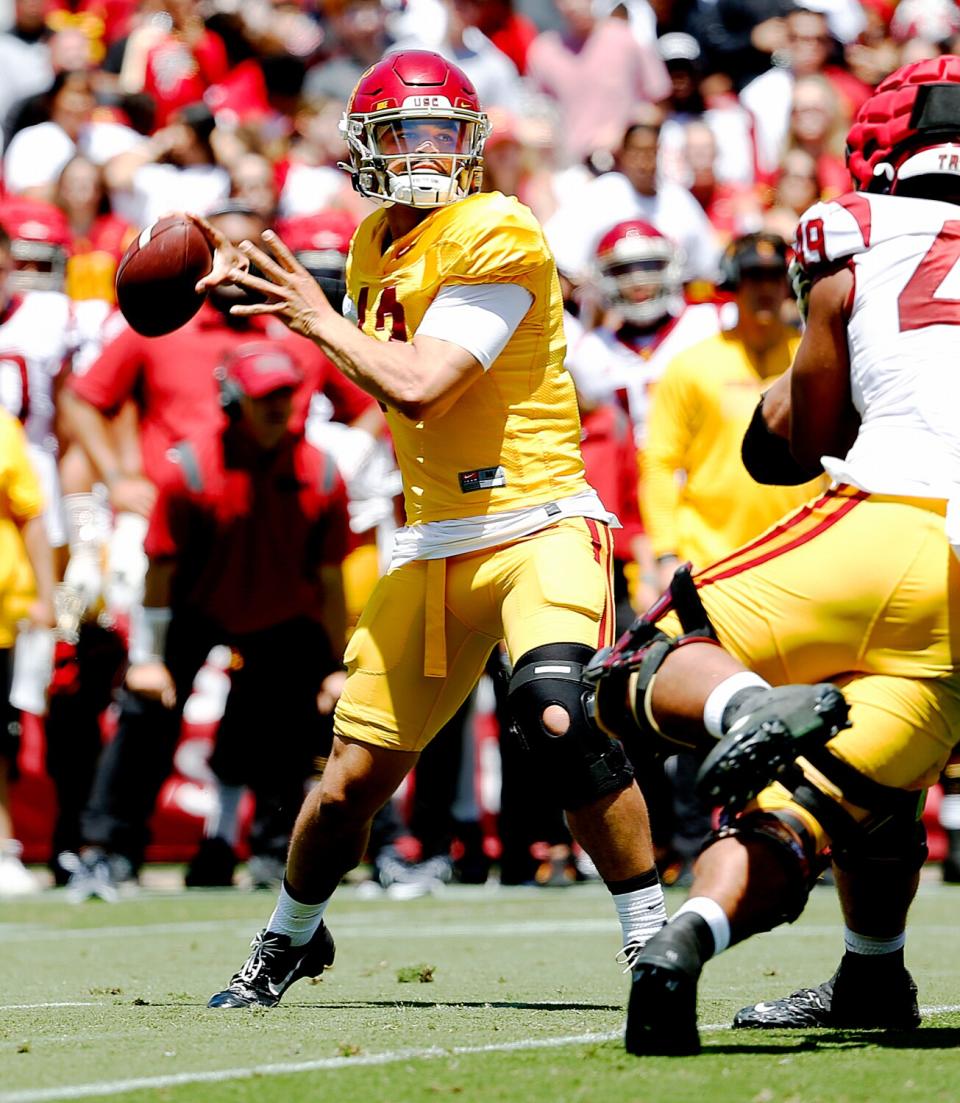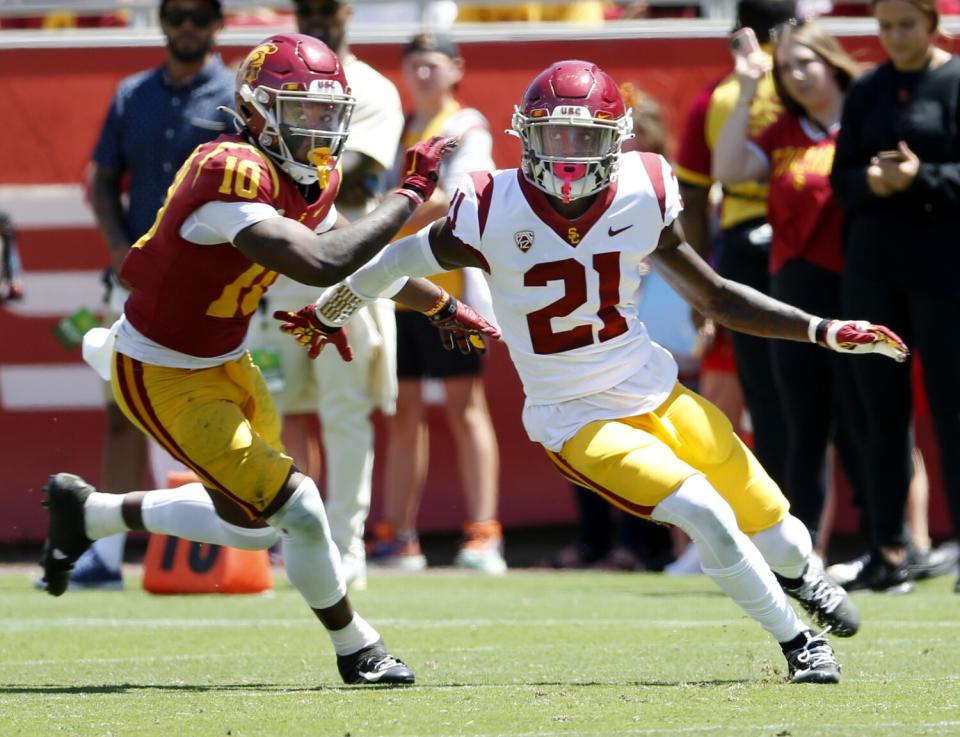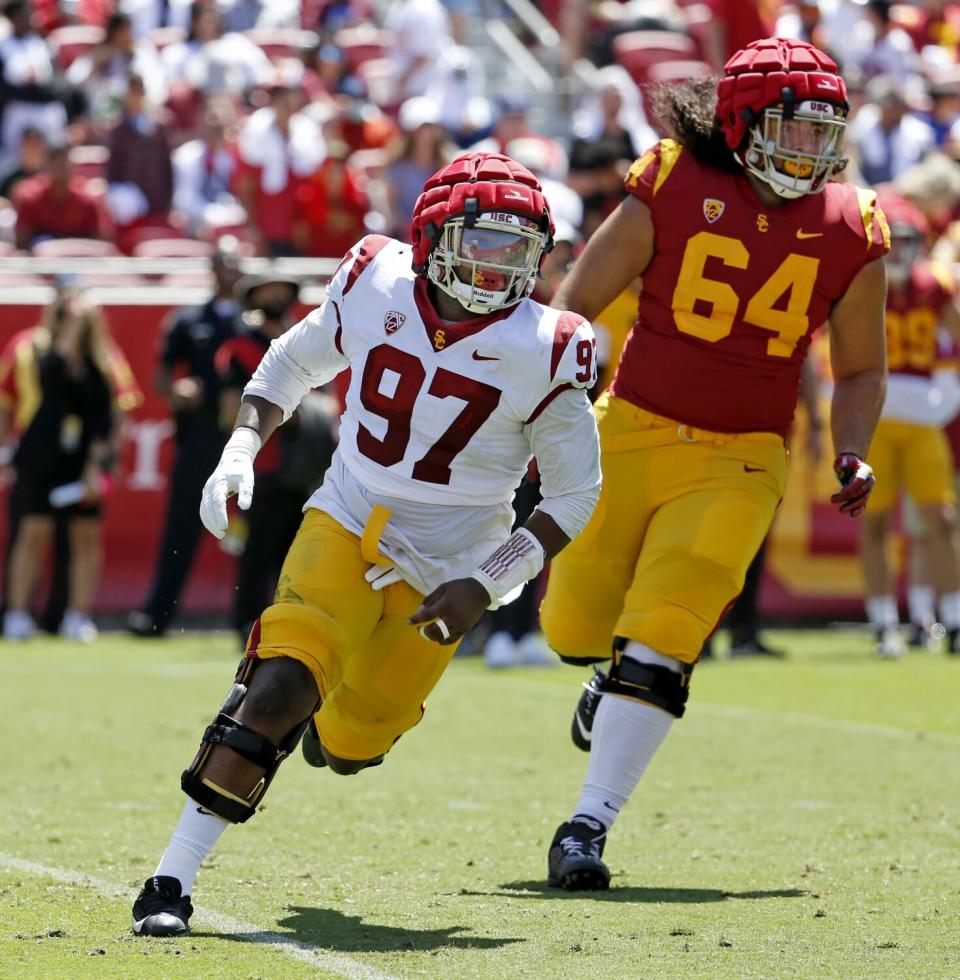USC spring game takeaways: Caleb Williams lives up to hype and others show promise

After months of build-up, Lincoln Riley stood in the Coliseum tunnel Saturday and allowed himself a deep exhale. He’d breathlessly assembled a new staff, revamped the roster via the transfer portal and laid the foundation for a new team culture, all since his stunning hire in late November. Now, after all that tireless reconstructing, the time had finally come to unveil the progress.
But first, USC’s new coach allowed himself a moment to enjoy his first stroll down the stadium’s tunnel. As he did, Riley couldn’t help but envision what it might feel like next fall.
“Certainly gives you chills,” he said. “Check your pulse if it doesn’t.”

Unlike past spring games at USC, there was an actual, discernible pulse to be found within the Coliseum. An announced crowd of 33,427 was in attendance Saturday — a record for the Trojans since they began tracking spring game turnout in the late 1990s. All were eager to get their first glimpse of Riley and his band of transfers, none of whom we’ve seen much of since spring practice began.
“If you’re in this city, and you don’t feel the momentum around this program, you’re not paying attention,” Riley said. “Our guys feel it right now.”
So how did those good vibes translate to the field Saturday? Here’s what we saw in what turned out to be a 34-30 spring scrimmage win for USC’s offense over the Trojans' defense.
Williams' debut

No performance was more hotly anticipated than USC’s new star quarterback, and his scorching start seemed to suggest the hype was warranted. Williams came out firing early, completing each of his first nine passes for 90 yards and two touchdowns. His poise in the pocket was especially impressive, as he deftly avoided any sign of pressure and wasn’t afraid to check down if necessary.
But the new quarterback cooled after his first two drives, completing just one more pass for eight yards. He was one of three in the second half, resulting in two three-and-out drives.
That was a credit, in part, to the USC defense's newfound ability to adjust. Williams was far more uncomfortable in the pocket after the first two drives, and a depleted secondary did well to limit plays down the field in the second half.
“Beginning was solid. The end, not so solid,” Williams said, when asked to evaluate his performance.
He’ll have plenty of time to iron out the kinks. But there’s no mistaking that the Trojans will go as far as their quarterback takes them this fall.
Moss' improvement

With the attention focused squarely on Williams, coaches say USC’s other scholarship quarterback has actually put together one of the best spring sessions of any player in the program. That progress was on display Saturday, as Miller Moss led the way for USC’s offense, completing 15 of 20 passes for 169 yards and a touchdown.
Moss uncorked the best throw of the day, finding wideout Kyle Ford deep down the field for a 48-yard touchdown.
“Once I saw it was one-on-one coverage, we’re going after them,” Moss said. “Kyle made a heck of a play.”
Moss was on the other end of the impressive toss — and a number of other plays that should go a long way in soothing any concerns about who backs up Williams.
Ford’s place in pecking order
When USC’s offense first lined up Saturday, Oklahoma transfer Mario Williams took one outside receiver spot. Terrell Bynum, a transfer from Washington, stood in the slot.
The general assumption this spring was that Colorado transfer Brenden Rice would be the other starting wideout in that trio. But it was Ford who took the field first.
The 6-foot-3, 220-pound redshirt junior would reel in just one catch Saturday, but he’d make it count, breaking through multiple tackles to finish a 48-yard touchdown.

He wasn’t the only returning wideout whose role appears to be growing. USC found multiple ways to involve Kyron Ware-Hudson, giving him the ball on an 18-yard end-around and also finding him for a team-leading four receptions.
Mario Williams is top target, for now
Considering the bond he already had with Caleb Williams, it should come as no surprise that Mario Williams seems several steps ahead when it comes to chemistry with USC’s quarterback.
A dynamic debut should solidify his place as USC’s top receiver for the time being. Twice, Williams got loose in the red zone, sprinting free to reel in two touchdowns over the Trojans’ first three drives. No one else in USC’s receiver corps comes close to the quickness off the line that Williams offers.

But Riley wasn’t about to crown Williams just yet.
“He’s done some good things early in his career,” Riley said, “but he’s still got a long ways to go.”
Let’s get physical
Few issues have been more glaring in recent seasons than USC’s dwindling physical presence up front, and while those issues aren’t about to go away overnight, Saturday was a good sign both USC’s offensive and defensive lines are headed in a positive direction.
“I thought the day was very representative of how the entire spring has gone,” Riley said. “The line of scrimmage was a battle the whole day.”
The defensive front held the offense to just 3.4 yards per carry, while USC’s linebackers — a major weakness last season — seemed much improved.

The first-team offensive line acquitted itself well, giving up only one sack. But there are still legitimate concerns about the depth behind those players. USC’s second-team offensive line consisted (from left to right) of Mason Murphy, Gino Quinones, Andrew Milek, Max Gibbs and walk-on Joe Bryson, none of whom have played a snap.
Tuli Tuipulotu and Romello Height, a potent combination
It should come as no surprise that Tuipulotu, easily USC’s top defender last season, has again established himself as a difference-maker, racking up two tackles for loss Saturday.
But Height’s strong debut is especially significant for a defense desperate for a pass rush. Height barely played at Auburn — and never had a sack in two years — but the transfer has been one of the most talked about players in camp.
Apparently that was for good reason. Height’s speed makes him a menace on the edge. He had a sack Saturday to go with several other disruptive plays.
Height appears to be ahead of Korey Foreman in USC’s pecking order of pass rushers. Considering his performance Saturday, that order doesn’t look as if it’ll be changing anytime soon.
This story originally appeared in Los Angeles Times.

